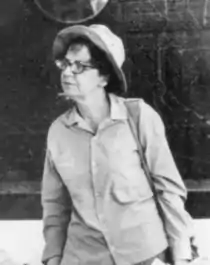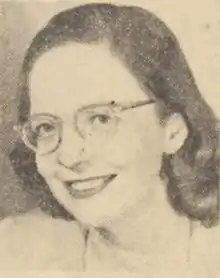Dorothy Drain
Dorothy Drain (1909–1996) was an Australian journalist, columnist, war correspondent, editor and poet. She worked as a journalist with The Australian Women's Weekly for 38 years, with the final five years being as its editor.[1][2] She was "one of Australia's best-known journalists".[2]
Dorothy Drain | |
|---|---|
 War correspondent in Vietnam, 1965 | |
| Born | Dorothy Simpson Drain 16 August 1909 Mount Morgan, Queensland, Australia |
| Died | 31 May 1996 (aged 86) |
| Occupation | Journalist, editor, poet |
| Nationality | Australian |
Early life and education
Drain was born Dorothy Simpson (Dot) Drain in Mount Morgan, Queensland on 16 August 1909. Her father, D. S. A. (David) Drain, was a headmaster of Scottish descent and her mother, Janet (sometimes referred to as Jean),[3] was of Irish descent. Her father had been a contributor for The Bulletin during the First World War.[1]
From the age of 2 until 12 she lived in Gracemere, near Rockhampton. In 1916 she enrolled in the Children's Corner in Rockhampton's Morning Bulletin.[4] In 1919 she won a prize from the Central Queensland Native Birds' Protection Association for the best essay on birdlife[5] and in the same period won other essay contests organised by the Rockhampton Agricultural Society and the Children's Corner of The Morning Bulletin and The Capricornian. In 1922 when she was just thirteen she was one of the winners of scholarships from the Department of Public Instruction with an "exceedingly creditable pass".[6]
From 1924 to 1926 she attended the Presbyterian Girls College, a private boarding school in Toowoomba, Queensland. She won the 1926 Brunton Stephens essay, commenting at the time: "printer's ink, inherited from [my] father, has an irresistible attraction" and that she intended to "follow up the call of journalism".[7]
Brisbane, then Sydney
Drain passed a Public Service examination and in 1927 accepted a position at the State Insurance Office in Brisbane.[8] During her leisure time she continued writing letters to newspapers, including one published in the Sydney Mail addressed to Cinderella which included references to Masefield, Shakespeare and Dickens.[9] She also had some of her short stories published.[10]
Drain obtained her first jobs as a journalist, with The Telegraph and then with The Courier-Mail in Brisbane. She moved to Sydney in 1936 and joined the Sydney Sun as a journalist.[11]
She began writing poetry, most of it with a humorous twist, which was published regularly in the satirical periodical Smith's Weekly.[2]
The Australian Women's Weekly
In 1938 Drain joined The Australian Women's Weekly. She would become that magazine's news editor in 1958, the assistant editor in 1970 and finally the editor in 1972 (succeeding Esmé Fenston in that role), a position she occupied until she retired in 1975. She was also appointed as one of the Board of Directors of the Australian Consolidated Press, which owned and published the Weekly.
In 1946 she went to Japan for three months and, attached to the Australian forces, reported on the Allied occupation of Japan at the end of Second World War.[12] She was the "first woman correspondent to visit the British Commonwealthy Occupation Force".[13][12] In 1950 she filed reports from Singapore and Malaya during the Emergency period and South Korea during the Korean War.[14] In 1965 she reported from Vietnam together with the Weekly photographer Ron Berg. She was "the first female Australian journalist to visit the troops in Vietnam".[15]

For more than fifteen years (from 1947 until 1963) Drain penned a "popular"[16] column of opinion and verse in the Weekly under the title "It Seems to Me...".[17] The column drew "a large volume of fan mail, much of it from men".[1]
She continued to write "brilliant" light verse which was published regularly in the Weekly, verse that was "witty, pointed but always human, satirical without being malicious" and through which much of her character revealed itself.[1][18][19][20][21]
A memorable career moment occurred in 1955 when she secured an interview with Frank Sinatra who was flying out to Australia for a tour. To do that she flew to Suva, joined Sinatra's flight and unexpectedly sat beside him on the plane.[22]
Personal life
In 1936 when she was a young journalist Drain was living at 4 Tusculum Street, Kings Cross, in the inner eastern suburbs of Sydney.[3] She would later write: "The reputation of The Cross was bohemian, even slightly wicked, just the sort of place to attract young people coming to the big city. In those days young people could afford to live there. You'd get a bedsitter for 25 shillings a week."[23][24]
She died of a heart attack on 31 May 1996. She had suffered from emphysema for many years.[2] She had never married.
References
- "Dorothy Drain Retires", The Australian Women's Weekly, 2 April 1975, p. 15. Retrieved 3 October 2020.
- Valerie Lawson, "Women's Weekly editor hid a streak of toughness. Obituary: Dorothy Drain (1909–1996)", The Sydney Morning Herald, 5 June 1996, p. 10.
- "Uncle Sam's Letter Bulletin", The Morning Bulletin, 3 June 1916, p. 13. Retrieved 3 October 2020.
- "Native Birds' Protection Association", The Morning Bulletin, 20 December 1919, p. 8. Retrieved 3 October 2020.
- "Personal News", The Morning Bulletin, 19 July 1922, p. 7. Retrieved 3 October 2020.
- "Miss Dorothy Drain", The Capricornian, 13 January 1927, p. 8. Retrieved 3 October 2020.
- "Personal", The Dalby Herald, 28 January 1927, p. 2. Retrieved 3 October 2020.
- "Honour Letter", Sydney Mail, 8 June 1027, p. 52. Retrieved 3 October 2020.
- "Compensation", The Sunday Mail (Brisbane), 13 April 1930, p. 32. Retrieved 4 October 2020.
- "Staff Presentation", The Telegraph (Brisbane), 7 March 1936, p. 15. Retrieved 3 October 2020.
- Dorothy Drain, "This is the Japan our troops have occupied", The Australian Women's Weekly, 20 April 1946, p. 17. Retrieved 3 October 2020.
- Dorothy Drain, "This is the Japan our troops have occupied", The Australian Women's Weekly, 20 April 1946, p. 17. Retrieved 3 October 2020.
- Dorothy Drain, "Dorothy Drain flies over Korean battlefield", 7 October 1950, p. 15. Retrieved 3 October 2020.
- Steve Meacham, "Pages for the ages: a quick flick through history", The Sydney Morning Herald, 3 August 2011. Retrieved 4 October 2020.
- The Australian Women's Weekly, womenaustralia.info. Retrieved 4 October 2020.
- It seems to me magazine article, dva.gov.au. Retrieved 3 October 2020.
- Dorothy Drain, "Progress", The Australian Women's Weekly, 1 December 1945, p. 15. Retrieved 5 October 2020.
- Dorothy Drain, "Thoughts after reading that Liz Taylor has a grandchild", The Australian Women's Weekly, 18 August 1971, p. 39. Retrieved 5 October 2020.
- "What's new - or is it?", The Australian Women's Weekly, 8 April 1970, p. 35. Retrieved 5 October 2020.
- Dorothy Drain, "Christmas, they say", The Australian Women's Weekly, 29 December 1954, p. 20. Retrieved 5 October 2020.
- Dorothy Drain, "Sinatra in Australia: His loves are work and his children", The Australian Women's Weekly, 26 January 1955, pp. 20-21. Retrieved 3 October 2020.
- "Cross currents", The Sydney Morning Herald, 31 May 2003. Retrieved 4 October 2020.
- "Extreme living", The Sydney Morning Herald, 31 May 2003. Retrieved 4 October 2020.
Further reading
- Jeannine Baker, Australian Women War Reporters: Boer War to Vietnam, Sydney: NewSouth Publishing, 2015.
- Denis O'Brien, The Weekly: A Lively and Nostalgic Celebration of Australia through 50 Years of its Most Popular Magazine, Ringwood, Victoria: Penguin Books, 1985.
- Entry "The Weekly's War", in: Scott Murray, ed., Australia on the Small Screen 1970-1995, Oxford University Press, 1996, p. 249.
External links
- Articles and verse by Dorothy Drain at National Library of Australia
- Dorothy Drain interviewed by Amy McGrath at National Library of Australia
- Biographical cuttings on Dorothy Drain, journalist at National Library of Australia
- Additional Resources on Dorothy Simpson (Dot) Drain (1909–1996)
- (Photo) Australian war correspondent, Miss Dorothy Drain, representing The Australian Women's Weekly, at Australian War Memorial